Formula One: 1991 Hungarian Grand Prix
McLaren Shell-shock
It used to be British Formula Three races — short 20 lappers — in which the start was all important. Today, there are Grand Prix races that are like that. Monaco is one, the Hungarian the other.
A paradox? On the face of it, yes. No two circuits could look more dissimilar, yet have so much in common. The Hungaroring may appear an open track, but with its low grip surface it actually demands more downforce than the Principality. Given the layout of the 2.465 mile venue, the dramatic reduction in braking distances brought about by carbon discs, and that need for so much downforce, overtaking opportunities are as rare as hen’s teeth. The start was thus paramount.
Before the race meeting, the betting men of F1 were busy saying how easy this one was going to be for Williams-Renault. After all, hadn’t Patrese dominated the 1989 event until his engine overheated after debris had punctured a radiator? Hadn’t Boutsen won in 1990 in the generally unloved FW13B? To many, the result seemed a foregone conclusion.
Renault itself wasn’t so sanguine. “Yes, our package has been very good in the past two years,” admitted RenaultSport boss Patrick Faure over dinner on Friday night, “but since then we have changed the characteristics of our engine. Then it was very strong on torque; now we have a stronger top-end, which is why it is good at places like Silverstone and Hockenheim, not so good in Monaco or here…”
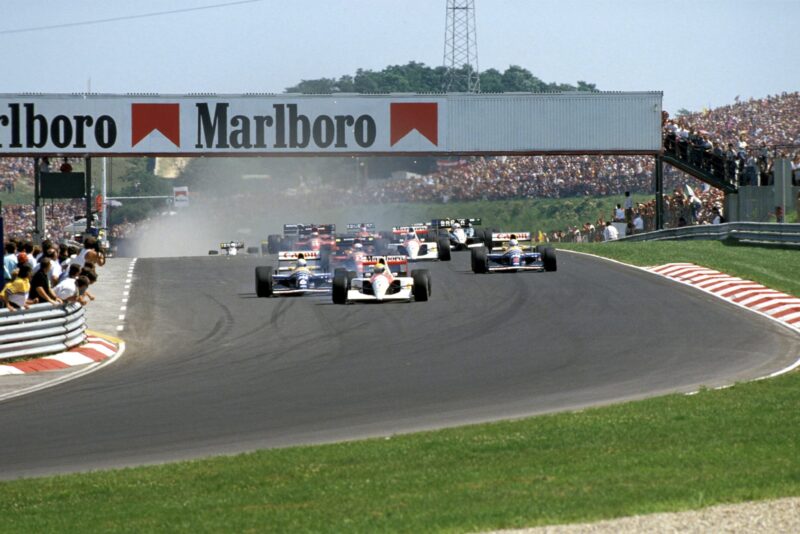
Senna leads into Turn One
Motorsport Images
That day had all been about Senna, Senna and a revitalised McLaren-Honda. Intensive development work by the technical partners had seen weight pared from chassis and engine and, they hoped, correction of the crippling fuel consumption readouts which had cost them points at Silverstone and Hockenheim. On top of that, Shell had developed yet another new fuel. “We don’t call it qualifying fuel,” beamed Mike Brannigan, but it certainly helped do the business as Senna demoralised his opposition once again to take his 57th pole position. “The car is a big improvement, and this is a good moment after one of the longest spells I have had away from the pole,” he beamed. And with Senna on pole you began to feel that the result into the first corner was almost totally predictable.
Alongside him after an excellent recovery from a shunt on Friday morning that had been caused by a faulty right front brake seal, was Riccardo Patrese, the man whose starts of late have been, by his own admission, appalling. The Italian had pipped team-mate Mansell by a hundredth of a second for the front row, as both Williams pilots had to struggle with the now unfamiliar supporting role into which Senna’s speed had thrust them. With more downforce and Honda power, Senna was in his element. As they struggled to match that downforce, the FW14s lacked grip and balance and their drivers were unhappy. The pendulum, in Hungary at least, was beginning to swing back into McLaren’s favour.
This time, Patrese surprised everyone with a brilliant getaway, and he was all but alongside Senna as they pounded into the tight first right-hander. Now Riccardo is one of F1 ‘s gentlemen, a driver marginally below the front rank, perhaps, but the one man currently racing in the category who seems totally at ease with himself. These days it is very rare to see him upset by anything. Yet after the race he had words with Ron Dennis on the victory rostrum, and in the post-race conference he remained unhappy.
“I make a good start, okay. We leave it at that,” said a man unwilling to wash dirty laundry in public. Pressed harder he opened up a little more. “I went straight, but somebody else maybe didn’t. But maybe this is just the latest method of starting…”
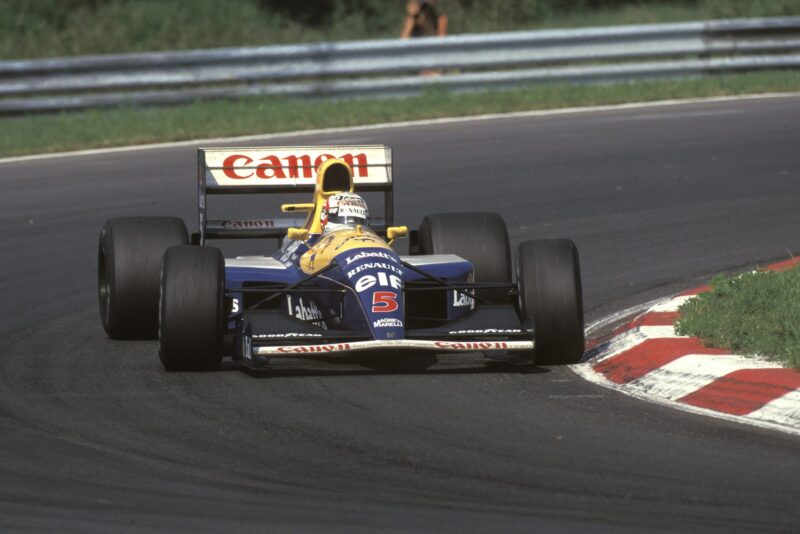
Nigel Mansell controls a slide in his Williams
Motorsport Images
The somebody, of course, was Senna, who had locked his brakes momentarily before diving across to claim the corner and the lead. The move would win him the race.
It was an interesting little bit of driver psychology, that start. On Friday both Senna and Alain Prost had been hauled before FISA stewards to discuss their conduct in the German GP, and for Prost to be informed that he faced a suspended one race ban for daring to criticise FISA. More importantly, they were both told that FISA’s Special Commission of Inquiry for Safety (the curiously acronymed SPICS) would be watching all driving tactics very closely. Senna probably did not need reminding of the tactics he had used to push Sandro Nannini out of his way in the 1990 race. This time he rationalised his start in a simple manner, almost surprised that Patrese should have objected.
“We were very close together,” he agreed with the smile of a winner who has seen his third championship coming into better focus. “We were on the limit. But you either go for it or you don’t at this stage of the championship. After four races where we were off the pace, it was possible for me to win. I had to go for it.” He looked across at Riccardo; “I’m sure you would have done the same to me.” The latter looked doubtful. Once the bête noire of F1, the Italian now has the reputation of a particularly clean competitor, and the question clearly troubled him. Should he really speak his mind, and become embroiled in the sort of aggravation that normally surrounds Senna, Prost and Mansell, or should he keep his good guy image? “Maybe, mmmm, maybe,” he responded unconvincingly.
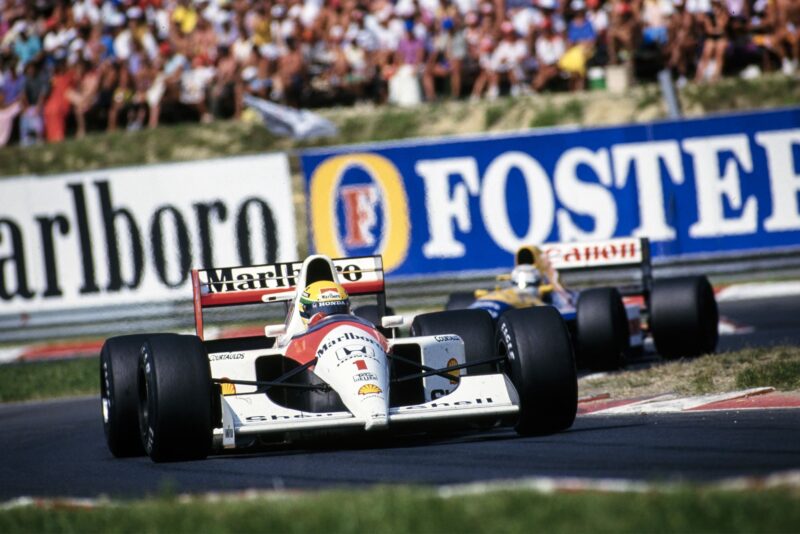
Senna leads Mansell through the chicane
Motorsport Images
Out in front at the end of that first lap, the race his if he could successfully stem the expected Williams challenge, Senna had something else to worry about on lap two. Where Williams had opted for Goodyear’s medium hard C race tyres all round, mindful of the high ambient temperatures and determined not to have to stop in what is a long, gruelling race, Senna plumped for Cs on the left and softer Ds on the right. The Ds took a while to stabilise on full tanks, and for an awful moment he feared he had a puncture, the McLaren was behaving so oddly.
“I told the pits and they said to come in, but I risked one more lap to be sure, and the tyres came in after that. It was a big relief!” Considering the shunt he had in testing at Hockenheim, due to a deflating tyre, it was a brave decision and an indication of his commitment to winning a third title.
In the early stages the Williamses looked faster than the McLaren. At the start of lap three Patrese had a very adventurous look at the inside down into turn one, and again he was pushing very hard on the 14th. In their wake, Mansell would either be right on their tails or some lengths behind, depending on how cool his engine was running, but just as he could close the gap at will, so too could Prost, running fourth in the Ferrari.
Since Hockenheim the Italian team had tested revised engines at Fiorano and Imola, but ironically it was a supposed screamer that let Prost down when it mattered on Saturday afternoon. That morning he had been as quick as Senna in free practice, but wound up only fourth in the afternoon. “With the engine I had this morning I would have been quicker for sure,” he said. “Not as quick as Ayrton, no, but on the front row. A 1m 16.7s, something like that.”
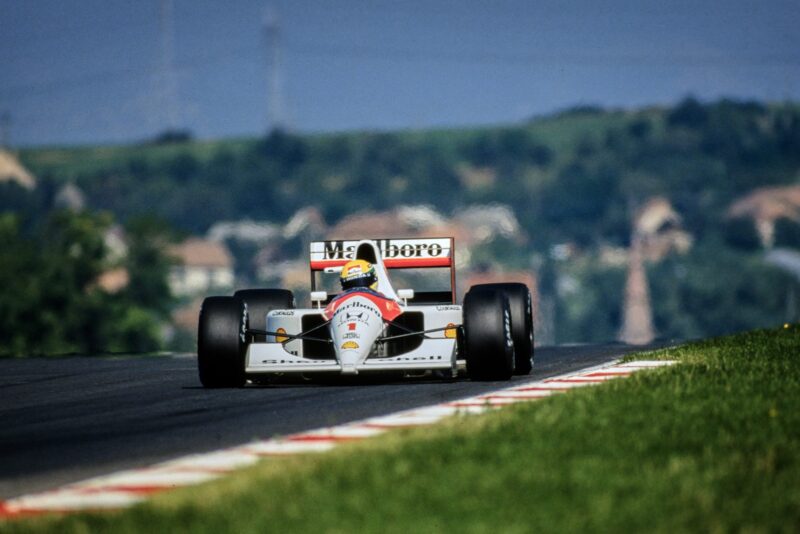
Ayrton Senna out in front and by himself
Motorsport Images
In those opening laps it was indeed the Frenchman who looked the darkest horse. As Senna, Patrese and Mansell set fastest laps as they crossed the line, so he would beat theirs on laps three, four and five. As late as lap 25 he was the fastest man on the track, running in clean air, apparently biding his time. Just as you thought the Williams could leave the McLaren if only they could pass it, so the Ferrari looked as if it might be able to outrun the Anglo-French racers.
It was not to be. On lap 28 Prost pulled into the pits with sudden engine failure, left to contemplate the Monza tests the following week, and the hokum with FISA. “It doesn’t upset me,” he commented drily on the latter. “It’s not for my driving, but because I spoke out against FISA. If it’s an attempt to gag me, it won’t work!”
Around lap 34 Riccardo really began to attack again, recording his fastest lap a 1m 22.878s on the 35th, but as he pushed, so his brakes began to fade and the pedal movement became alarmingly longer. It was a worse version of the problem that afflicted Mansell in Germany, and for Riccardo it spelled an end to his hopes of victory. As the two Williams came down the pit straight on lap 44, Riccardo raised a hand and waved Nigel by. It was the act of a team player, just as the way he’d protected Boutsen’s lead in 1990 had been, and threw Mansell’s tactics against him in Phoenix in the season opener into harsh relief.
Now, we all thought, Mansell will charge. The race is just really beginning. And charge Nigel did, thrusting his way on to Senna’s tail. At the end of lap 48 the two cars were nose to tail across the finishing line, with Mansell jockeying for the inside line down into turn one. Senna just held him off, and it transpired that that was the sternest challenge he would have to face for the remainder of the race. Shortly afterwards, on lap 57, the race effectively was over. Lap 56 took Senna 1m 22.583s, while Mansell set his fastest time of 1m 22.574s His next was two seconds slower than Ayrton’s, and then the gap was the biggest it had been between first and second all race. Mansell admitted later that he’d nearly run into the back of Senna at one stage, as he suffered the same long brake pedal problem that had visited itself upon Patrese, and thereafter six points looked a lot more sensible than none. If McLaren and Honda staged some dramatic damage limitation by stealing a race from Williams, before the high-speed blasts at Spa and Monza which ought to favour the FW14s, then Williams too at least stopped some rot with second and third places. If they couldn’t win on the day, they couldn’t have done much better.
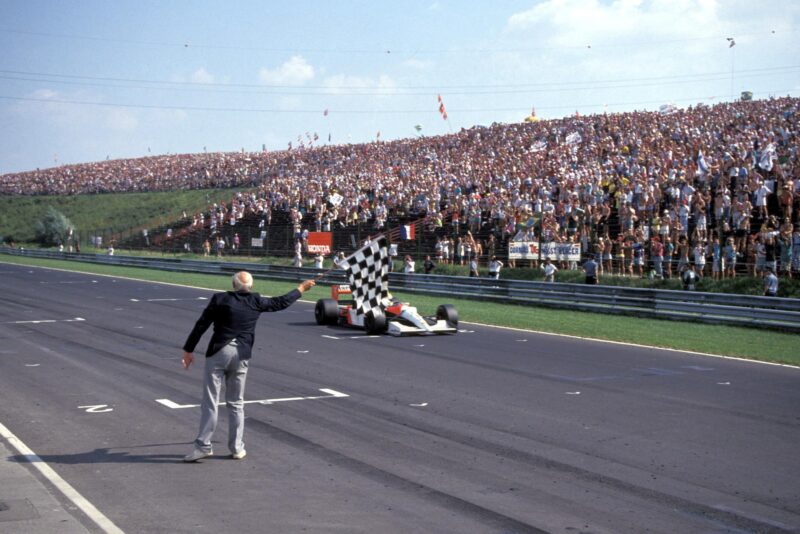
Senna takes the chequered flag to win the Hungarian Grand Prix
Motorsport Images
In a weekend in which Patrese was the only number two to run with the foxes, Berger and Alesi had disappointing runs to fourth and fifth places. On Friday the Austrian had raised eyebrows by pipping Senna for the overnight pole, and there began a round of optimistic ‘Berger’s going to win at last’ comments. They proved unfounded by a long way as he plugged round in fifth place until inheriting fourth from Prost. Likewise, Jean was overshadowed by ‘Papa’ Prost, as he calls The Professor.
There was an interesting little scenario at the Ferrari motorhome on Saturday, when the time came for the usual press briefing. Jean, it seemed, was sick, unable to speak to the media. In fact, it transpired that he’d been muzzled after criticising the engine he was given, and had been told he couldn’t appear!
In the race his Ferrari lost power progressively, and after dumping his Cs for a set of Ds on lap 25 he dropped a place to Ivan Capelli and then steadily soldiered back until he was able to catch the Leyton House and regain fifth. After his super drive at Hockenheim, it was a big disappointment to him.
Capelli’s result was anything but for Leyton House and Ilmor Engineering, as he gained the former its first point of the season and the latter its first ever. Right from Friday morning the Italian was able to exploit the benefits of recent testing at Silverstone, and for once had a CG911 that actually worked over bumps. He was lucky to get around surprise seventh fastest qualifier Pirro at the start, and ran steadily in seventh place until Prost’s demise. If it was a surprise that there were no retirements until the Frenchman disappeared on lap 28, it was also unusual to see the Miami blue car make it all the way home at full racing pace, and that in itself was a welcome sign that the team is finally making some serious progress.
There were similar signs from Brabham-Yamaha, too, with Brundle qualifying very well and Blundell only failing to do so through an engine fire during his first Saturday afternoon run. The BT60Ys looked very good for some time as Brundle finally found a way by Pirro (troubled by his soft Pirellis deteriorating early in the race). Martin then ran in a good-looking eighth place behind Capelli until pitting on lap 29. He resumed 12th in the middle of what remained of the gaggle of cars (Lehto, Modena, Gachot, Moreno, Piquet, Martini, de Cesaris and Bernard) that had battled for 10th place on the opening lap, but his chances of pulling through to resume the chase of Capelli were nullified by severe foot cramps that would eventually oblige him to retire. Sadly, team-mate Blundell also failed to finish, spinning off in turn one after a dogged battle for 12th spot with Comas, Martini, Boutsen and Modena.
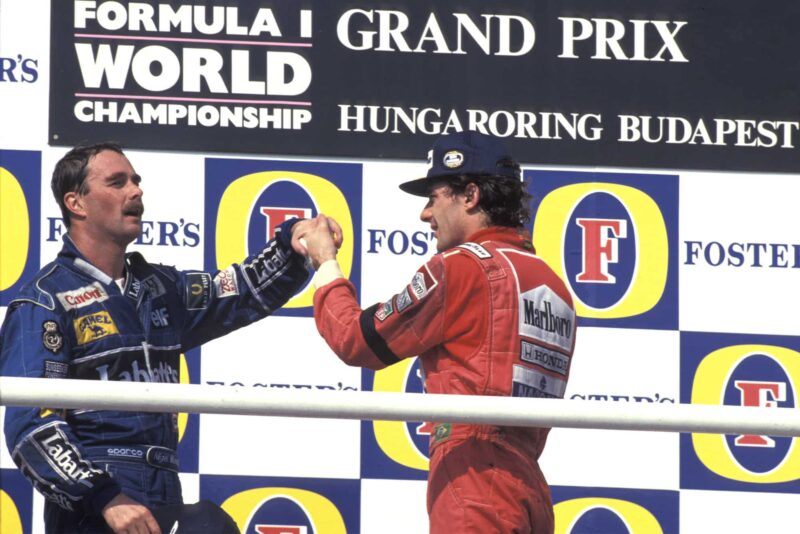
Senna and Mansell shake hands on the podium after the race
Motorsport Images
Thus the Team 7Up Jordans came through for seventh and ninth places, sandwiching Moreno in the sole surviving Benetton; Nelson Piquet’s had quit on lap 39 with a broken gearbox. In qualifying the Irishman’s cars had discovered the unpleasant fact that they, like Williams, lacked downforce, but in the race they were much better and Gachot was heading for a deserved seventh until his pace killed his right front Goodyear. Switching from Cs to Ds in a lap 69 stop, he then set fastest lap and a new record on the 71st before losing seven seconds with a quick spin on the 72nd. “Every lap was like qualifying!” he beamed.
For everyone else Hungary flattered only to deceive. Comas did well to take 10th, but team-mate Boutsen, the 1991 winner, had just passed him for the place when his Ligier’s Lamborghini engine exploded. It had been leaking oil for some laps. Martini blew up, while team-mate Morbidelli was delayed by an early stop and then tigered up to 13th behind an unhappy Gugelmin and Modena, who spun when Gachot outbraked him into turn one on lap 35, and then spun on his own later in the race. At one stage he snagged Pirro as the latter spun while coming in for fresh Pirellis, and Scuderia Italia’s once promising day ended with the Italian stopping with a broken engine and team-mate JJ Lehto following suit after coping with a clutch problem for most of his running time. The two Larrousse Lolas raced near the back, the season-long financial problems that face the team continuing to hurt their performances. Both Bernard and Suzuki retired with broken Hart DFRs, which left Hakkinen to soldier his Lotus home 14th after catching and passing Larini and a distinctly unimpressive Nakajima.
The F1 circus headed for Spa via the Monza test, and everyone began confidently predicting a return to Williams domination of the fast tracks. But given the upset in Hungary, no rational man would seek certainties in the current World Championship battle. In the coming six races, anything could now happen.– DJT
***
Results (top five), Hungarian GP, Budapest, August 11
77 laps of 3.968 km circuit (305.536 km; 189.851 miles)
1. Ayrton Senna, BRA, (McLaren MP4/6 – Honda V12) 1h 49m 12.796s
2. Nigel Mansell, GB, (Williams FW14 – Renault V10) 1h 49m 17.395s
3. Riccardo Patrese, I, (Williams FW14 – Renault V10) 1h 49m 28.390s
4. Gerhard Berger, AUT, (McLaren MP4/6 – Honda V12) 1h 49m 34.652s
5. Jean Alesi, F, (Ferrari F1/91B – Ferrari V12) 1h 49m 44.185s
Conditions: Very hot
Winner’s Average Speed: 167.857 kph (104.301 mph)
Fastest Lap: Bertrand Gachot (Jordan 191- Cosworth V8 HB) 1m 21.547s on lap 71; 175.173 kph (108.847 mph).
